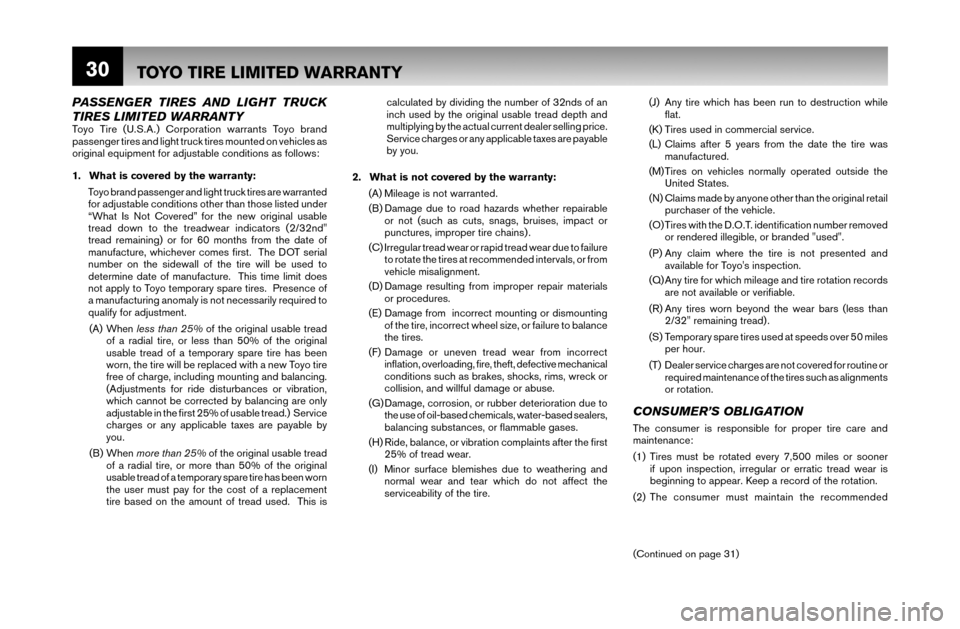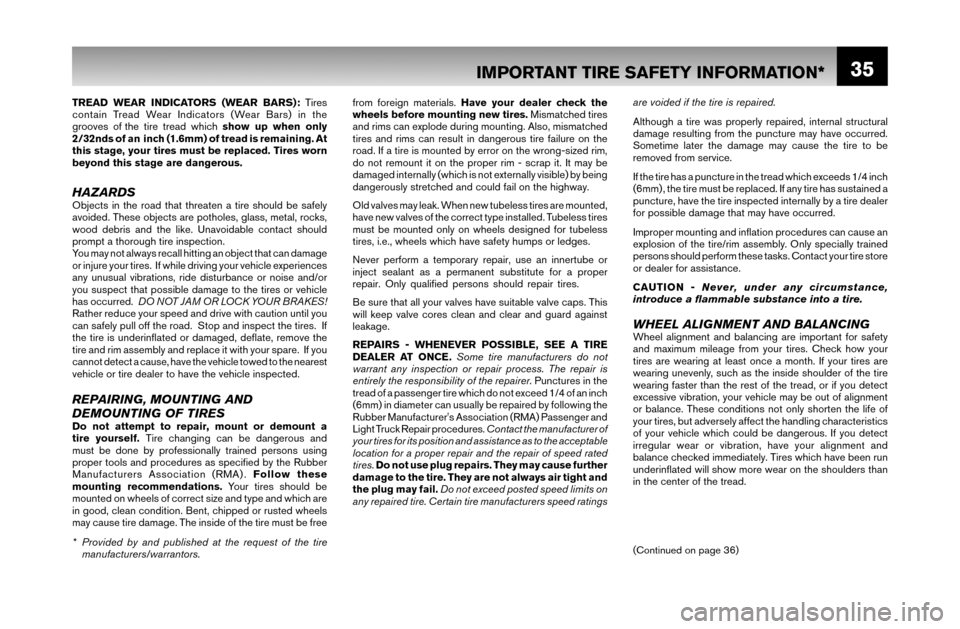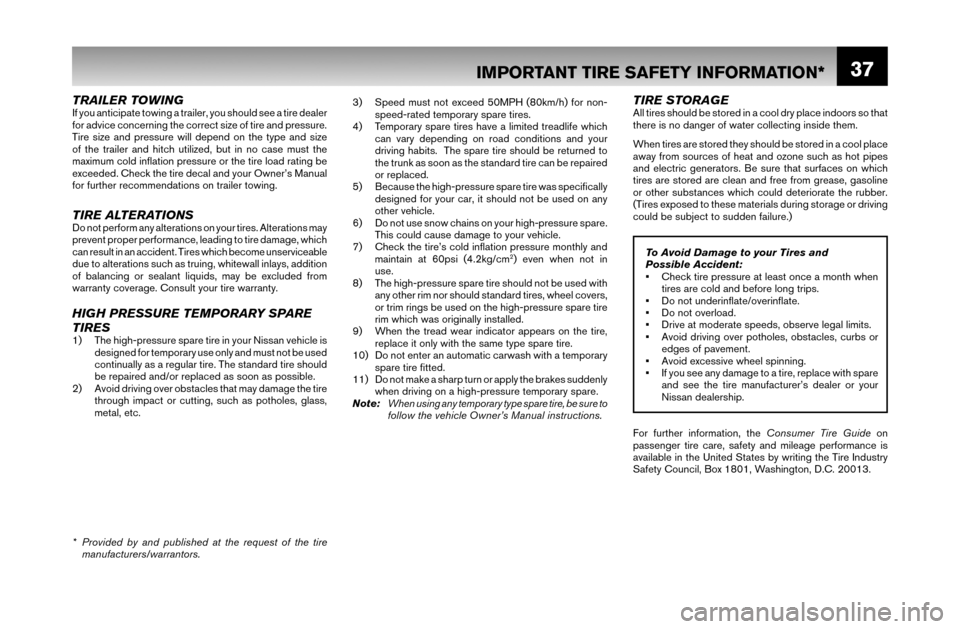2007 NISSAN MAXIMA service indicator
[x] Cancel search: service indicatorPage 33 of 55

30
PASSENGER TIRES AND LIGHT TRUCK
TIRES LIMITED WARRANTY
Toyo Tire (U.S.A.) Corporation warrants Toyo brand
passenger tires and light truck tires mounted on vehicles as
original equipment for adjustable conditions as follows:
1. What is covered by the warranty:
Toyo brand passenger and light truck tires are warranted
for adjustable conditions other than those listed under
“What Is Not Covered” for the new original usable
tread down to the treadwear indicators (2/32nd"
tread remaining) or for 60 months from the date of
manufacture, whichever comes fi rst. The DOT serial
number on the sidewall of the tire will be used to
determine date of manufacture. This time limit does
not apply to Toyo temporary spare tires. Presence of
a manufacturing anomaly is not necessarily required to
qualify for adjustment.
(A) When less than 25% of the original usable tread
of a radial tire, or less than 50% of the original
usable tread of a temporary spare tire has been
worn, the tire will be replaced with a new Toyo tire
free of charge, including mounting and balancing.
(Adjustments for ride disturbances or vibration,
which cannot be corrected by balancing are only
adjustable in the fi rst 25% of usable tread.) Service
charges or any applicable taxes are payable by
you.
(B) When more than 25% of the original usable tread
of a radial tire, or more than 50% of the original
usable tread of a temporary spare tire has been worn
the user must pay for the cost of a replacement
tire based on the amount of tread used. This is calculated by dividing the number of 32nds of an
inch used by the original usable tread depth and
multiplying by the actual current dealer selling price.
Service charges or any applicable taxes are payable
by you.
2. What is not covered by the warranty:
(A) Mileage is not warranted.
(B) Damage due to road hazards whether repairable
or not (such as cuts, snags, bruises, impact or
punctures, improper tire chains) .
(C) Irregular tread wear or rapid tread wear due to failure
to rotate the tires at recommended intervals, or from
vehicle misalignment.
(D) Damage resulting from improper repair materials
or procedures.
(E) Damage from incorrect mounting or dismounting
of the tire, incorrect wheel size, or failure to balance
the tires.
(F) Damage or uneven tread wear from incorrect
infl ation, overloading, fi re, theft, defective mechanical
conditions such as brakes, shocks, rims, wreck or
collision, and willful damage or abuse.
(G) Damage, corrosion, or rubber deterioration due to
the use of oil-based chemicals, water-based sealers,
balancing substances, or fl ammable gases.
(H) Ride, balance, or vibration complaints after the fi rst
25% of tread wear.
(I) Minor surface blemishes due to weathering and
normal wear and tear which do not affect the
serviceability of the tire.(J) Any tire which has been run to destruction while
fl a t .
(K) Tires used in commercial service.
(L) Claims after 5 years from the date the tire was
manufactured.
(M) Tires on vehicles normally operated outside the
United States.
(N) Claims made by anyone other than the original retail
purchaser of the vehicle.
(O) Tires with the D.O.T. identifi cation number removed
or rendered illegible, or branded "used".
(P) Any claim where the tire is not presented and
available for Toyo's inspection.
(Q) Any tire for which mileage and tire rotation records
are not available or verifi able.
(R) Any tires worn beyond the wear bars (less than
2/32" remaining tread) .
(S) Temporary spare tires used at speeds over 50 miles
per hour.
(T) Dealer service charges are not covered for routine or
required maintenance of the tires such as alignments
or rotation.
CONSUMER’S OBLIGATION
The consumer is responsible for proper tire care and
maintenance:
(1) Tires must be rotated every 7,500 miles or sooner
if upon inspection, irregular or erratic tread wear is
beginning to appear. Keep a record of the rotation.
(2) The consumer must maintain the recommended
TOYO TIRE LIMITED WARRANTY
(Continued on page 31)
57052 Booklet text pages.indd 3057052 Booklet text pages.indd 308/30/06 3:34:24 PM8/30/06 3:34:24 PM
Page 38 of 55

35
TREAD WEAR INDICATORS (WEAR BARS): Tires
contain Tread Wear Indicators (Wear Bars) in the
grooves of the tire tread which show up when only
2/32nds of an inch (1.6mm) of tread is remaining. At
this stage, your tires must be replaced. Tires worn
beyond this stage are dangerous.
HAZARDSObjects in the road that threaten a tire should be safely
avoided. These objects are potholes, glass, metal, rocks,
wood debris and the like. Unavoidable contact should
prompt a thorough tire inspection.
You may not always recall hitting an object that can damage
or injure your tires. If while driving your vehicle experiences
any unusual vibrations, ride disturbance or noise and/or
you suspect that possible damage to the tires or vehicle
has occurred. DO NOT JAM OR LOCK YOUR BRAKES!
Rather reduce your speed and drive with caution until you
can safely pull off the road. Stop and inspect the tires. If
the tire is underinfl ated or damaged, defl ate, remove the
tire and rim assembly and replace it with your spare. If you
cannot detect a cause, have the vehicle towed to the nearest
vehicle or tire dealer to have the vehicle inspected.
REPAIRING, MOUNTING AND
DEMOUNTING OF TIRES
Do not attempt to repair, mount or demount a
tire yourself. Tire changing can be dangerous and
must be done by professionally trained persons using
proper tools and procedures as specifi ed by the Rubber
Manufacturers Association (RMA) . Follow these
mounting recommendations. Your tires should be
mounted on wheels of correct size and type and which are
in good, clean condition. Bent, chipped or rusted wheels
may cause tire damage. The inside of the tire must be free from foreign materials. Have your dealer check the
wheels before mounting new tires. Mismatched tires
and rims can explode during mounting. Also, mismatched
tires and rims can result in dangerous tire failure on the
road. If a tire is mounted by error on the wrong-sized rim,
do not remount it on the proper rim - scrap it. It may be
damaged internally (which is not externally visible) by being
dangerously stretched and could fail on the highway.
Old valves may leak. When new tubeless tires are mounted,
have new valves of the correct type installed. Tubeless tires
must be mounted only on wheels designed for tubeless
tires, i.e., wheels which have safety humps or ledges.
Never perform a temporary repair, use an innertube or
inject sealant as a permanent substitute for a proper
repair. Only qualifi ed persons should repair tires.
Be sure that all your valves have suitable valve caps. This
will keep valve cores clean and clear and guard against
leakage.
REPAIRS - WHENEVER POSSIBLE, SEE A TIRE
DEALER AT ONCE. Some tire manufacturers do not
warrant any inspection or repair process. The repair is
entirely the responsibility of the repairer. Punctures in the
tread of a passenger tire which do not exceed 1/4 of an inch
(6mm) in diameter can usually be repaired by following the
Rubber Manufacturer's Association (RMA) Passenger and
Light Truck Repair procedures. Contact the manufacturer of
your tires for its position and assistance as to the acceptable
location for a proper repair and the repair of speed rated
tires. Do not use plug repairs. They may cause further
damage to the tire. They are not always air tight and
the plug may fail. Do not exceed posted speed limits on
any repaired tire. Certain tire manufacturers speed ratings are voided if the tire is repaired.
Although a tire was properly repaired, internal structural
damage resulting from the puncture may have occurred.
Sometime later the damage may cause the tire to be
removed from service.
If the tire has a puncture in the tread which exceeds 1/4 inch
(6mm) , the tire must be replaced. If any tire has sustained a
puncture, have the tire inspected internally by a tire dealer
for possible damage that may have occurred.
Improper mounting and infl ation procedures can cause an
explosion of the tire/rim assembly. Only specially trained
persons should perform these tasks. Contact your tire store
or dealer for assistance.
CAUTION - Never, under any circumstance,
introduce a fl ammable substance into a tire.
WHEEL ALIGNMENT AND BALANCINGWheel alignment and balancing are important for safety
and maximum mileage from your tires. Check how your
tires are wearing at least once a month. If your tires are
wearing unevenly, such as the inside shoulder of the tire
wearing faster than the rest of the tread, or if you detect
excessive vibration, your vehicle may be out of alignment
or balance. These conditions not only shorten the life of
your tires, but adversely affect the handling characteristics
of your vehicle which could be dangerous. If you detect
irregular wear or vibration, have your alignment and
balance checked immediately. Tires which have been run
underinfl ated will show more wear on the shoulders than
in the center of the tread.
* Provided by and published at the request of the tire
manufacturers/warrantors.
IMPORTANT TIRE SAFETY INFORMATION*
(Continued on page 36)
57052 Booklet text pages.indd 3557052 Booklet text pages.indd 358/30/06 3:34:27 PM8/30/06 3:34:27 PM
Page 40 of 55

37
TRAILER TOWINGIf you anticipate towing a trailer, you should see a tire dealer
for advice concerning the correct size of tire and pressure.
Tire size and pressure will depend on the type and size
of the trailer and hitch utilized, but in no case must the
maximum cold infl ation pressure or the tire load rating be
exceeded. Check the tire decal and your Owner’s Manual
for further recommendations on trailer towing.
TIRE ALTERATIONSDo not perform any alterations on your tires. Alterations may
prevent proper performance, leading to tire damage, which
can result in an accident. Tires which become unserviceable
due to alterations such as truing, whitewall inlays, addition
of balancing or sealant liquids, may be excluded from
warranty coverage. Consult your tire warranty.
HIGH PRESSURE TEMPORARY SPARE
TIRES
1) The high-pressure spare tire in your Nissan vehicle is
designed for temporary use only and must not be used
continually as a regular tire. The standard tire should
be repaired and/or replaced as soon as possible.
2) Avoid driving over obstacles that may damage the tire
through impact or cutting, such as potholes, glass,
metal, etc.3) Speed must not exceed 50MPH (80km/h) for non-
speed-rated temporary spare tires.
4) Temporary spare tires have a limited treadlife which
can vary depending on road conditions and your
driving habits. The spare tire should be returned to
the trunk as soon as the standard tire can be repaired
or replaced.
5) Because the high-pressure spare tire was specifi cally
designed for your car, it should not be used on any
other vehicle.
6) Do not use snow chains on your high-pressure spare.
This could cause damage to your vehicle.
7) Check the tire’s cold infl ation pressure monthly and
maintain at 60psi (4.2kg/cm
2) even when not in
use.
8) The high-pressure spare tire should not be used with
any other rim nor should standard tires, wheel covers,
or trim rings be used on the high-pressure spare tire
rim which was originally installed.
9) When the tread wear indicator appears on the tire,
replace it only with the same type spare tire.
10) Do not enter an automatic carwash with a temporary
spare tire fi tted.
11) Do not make a sharp turn or apply the brakes suddenly
when driving on a high-pressure temporary spare.
Note: When using any temporary type spare tire, be sure to
follow the vehicle Owner’s Manual instructions.
TIRE STORAGEAll tires should be stored in a cool dry place indoors so that
there is no danger of water collecting inside them.
When tires are stored they should be stored in a cool place
away from sources of heat and ozone such as hot pipes
and electric generators. Be sure that surfaces on which
tires are stored are clean and free from grease, gasoline
or other substances which could deteriorate the rubber.
(Tires exposed to these materials during storage or driving
could be subject to sudden failure.)
To Avoid Damage to your Tires and
Possible Accident:
• Check tire pressure at least once a month when
tires are cold and before long trips.
• Do not underinfl ate/overinfl ate.
• Do not overload.
• Drive at moderate speeds, observe legal limits.
• Avoid driving over potholes, obstacles, curbs or
edges of pavement.
• Avoid excessive wheel spinning.
• If you see any damage to a tire, replace with spare
and see the tire manufacturer’s dealer or your
Nissan dealership.
For further information, the Consumer Tire Guide on
passenger tire care, safety and mileage performance is
available in the United States by writing the Tire Industry
Safety Council, Box 1801, Washington, D.C. 20013.
* Provided by and published at the request of the tire
manufacturers/warrantors.
IMPORTANT TIRE SAFETY INFORMATION*
57052 Booklet text pages.indd 3757052 Booklet text pages.indd 378/30/06 3:34:28 PM8/30/06 3:34:28 PM